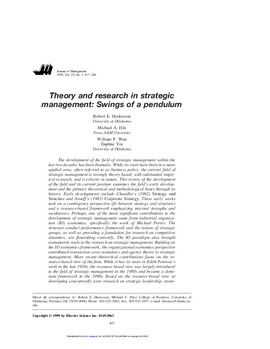| dc.contributor.author | Robert E. Hoskisson | |
| dc.contributor.author | Michael A. Hitt | |
| dc.contributor.author | William P. Wan | |
| dc.contributor.author | Daphne Yiu | |
| dc.date.accessioned | 2016-01-14T19:52:59Z | |
| dc.date.accessioned | 2016-03-30T15:33:15Z | |
| dc.date.available | 2016-01-14T19:52:59Z | |
| dc.date.available | 2016-03-30T15:33:15Z | |
| dc.date.issued | 1999-06-01 | |
| dc.identifier.citation | Hoskisson, R. E., Hitt, M. A., Wan, W. P., & Yiu, D. (1999). Theory and research in strategic management: Swings of a pendulum. Journal of Management, 25(3), 417-456. doi: 10.1177/014920639902500307 | en_US |
| dc.identifier.uri | https://hdl.handle.net/11244/25001 | |
| dc.description.abstract | The development of the field of strategic management within the last two decades has been dramatic. While its roots have been in a more applied area, often referred to as business policy, the current field of strategic management is strongly theory based, with substantial empirical research, and is eclectic in nature. This review of the development of the field and its current position examines the field’s early development and the primary theoretical and methodological bases through its history. Early developments include Chandler’s (1962) Strategy and Structure and Ansoff’s (1965) Corporate Strategy. These early works took on a contingency perspective (fit between strategy and structure) and a resource-based framework emphasizing internal strengths and weaknesses. Perhaps, one of the more significant contributions to the development of strategic management came from industrial organization (IO) economics, specifically the work of Michael Porter. The structure-conduct-performance framework and the notion of strategic groups, as well as providing a foundation for research on competitive dynamics, are flourishing currently. The IO paradigm also brought econometric tools to the research on strategic management. Building on the IO economics framework, the organizational economics perspective contributed transaction costs economics and agency theory to strategic management. More recent theoretical contributions focus on the resource-based view of the firm. While it has its roots in Edith Penrose’s work in the late 1950s, the resource-based view was largely introduced to the field of strategic management in the 1980s and became a dominant framework in the 1990s. Based on the resource-based view or developing concurrently were research on strategic leadership, strategic decision theory (process research) and knowledge-based view of the firm. The research methodologies are becoming increasingly sophisticated and now frequently combine both quantitative and qualitative approaches and unique and new statistical tools. Finally, this review examines the future directions, both in terms of theory and methodologies, as the study of strategic management evolves. | en_US |
| dc.language.iso | en_US | en_US |
| dc.publisher | Journal of Management | |
| dc.title | Theory and research in strategic management: Swings of a pendulum | en_US |
| dc.type | Research Article | en_US |
| dc.description.peerreview | Yes | en_US |
| dc.description.peerreviewnotes | https://us.sagepub.com/en-us/nam/manuscript-submission-guidelines | en_US |
| dc.identifier.doi | 10.1177/014920639902500307 | en_US |
| dc.rights.requestable | false | en_US |
